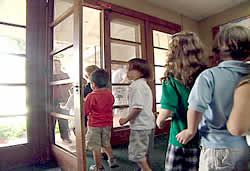 Transitioning from one activity to another is often the most challenging time of the day. Just as you have lesson plans for the activities you do in your centers, during circle time, on the playground, and throughout the day, you also need to have a plan for transition times. Transitions are particularly difficult for children who are English language learners or children with other special needs. During transitions, there is usually some level of commotion, the directions are typically spoken by the teacher, and the child is not always able to rely on classmates to determine what she/he is supposed to do. Young children with limited English language skills benefit the most when both visual and auditory signals are used to transition into the next activity. Using routines such as the following help children learn what to expect during a transition period:
Transitioning from one activity to another is often the most challenging time of the day. Just as you have lesson plans for the activities you do in your centers, during circle time, on the playground, and throughout the day, you also need to have a plan for transition times. Transitions are particularly difficult for children who are English language learners or children with other special needs. During transitions, there is usually some level of commotion, the directions are typically spoken by the teacher, and the child is not always able to rely on classmates to determine what she/he is supposed to do. Young children with limited English language skills benefit the most when both visual and auditory signals are used to transition into the next activity. Using routines such as the following help children learn what to expect during a transition period:
- Sing a song with lyrics in both English and Spanish to signal the end of an activity.
- Use a puppet to call children individually to come to an area. When they see the puppet, they know that soon their name will be called.
- Use gestures and actions along with verbal directions to facilitate transitions. Using sentence strips (see “Labels and Signs” above) in both English and the native language of the children helps teachers communicate bilingually.
Watch how some teachers use various ways to transition from activity to activity in the video below.
|
To begin the video, press the "play" |
Please refer to Section 5: Resources for materials that may provide ideas on transition activities.